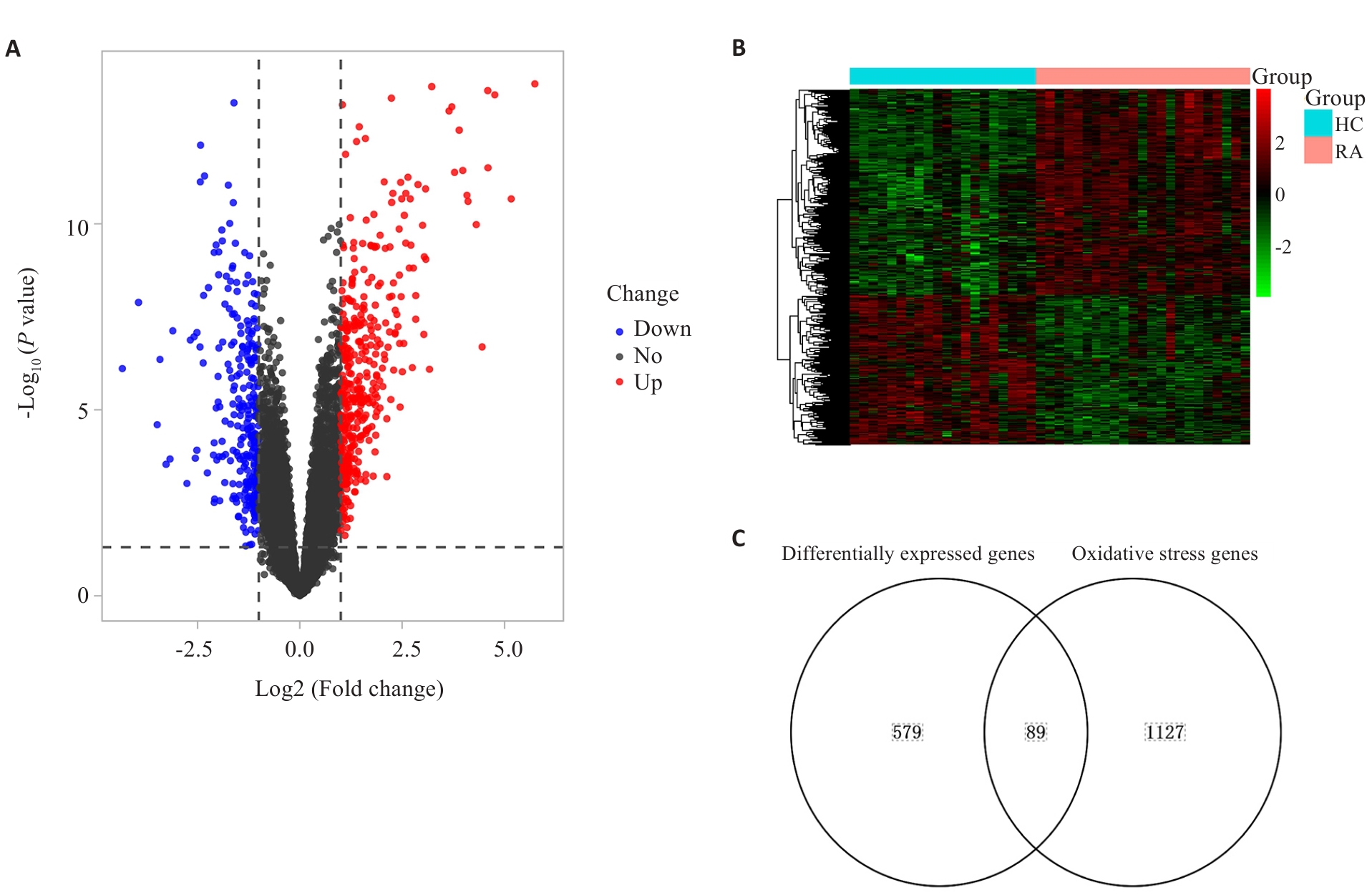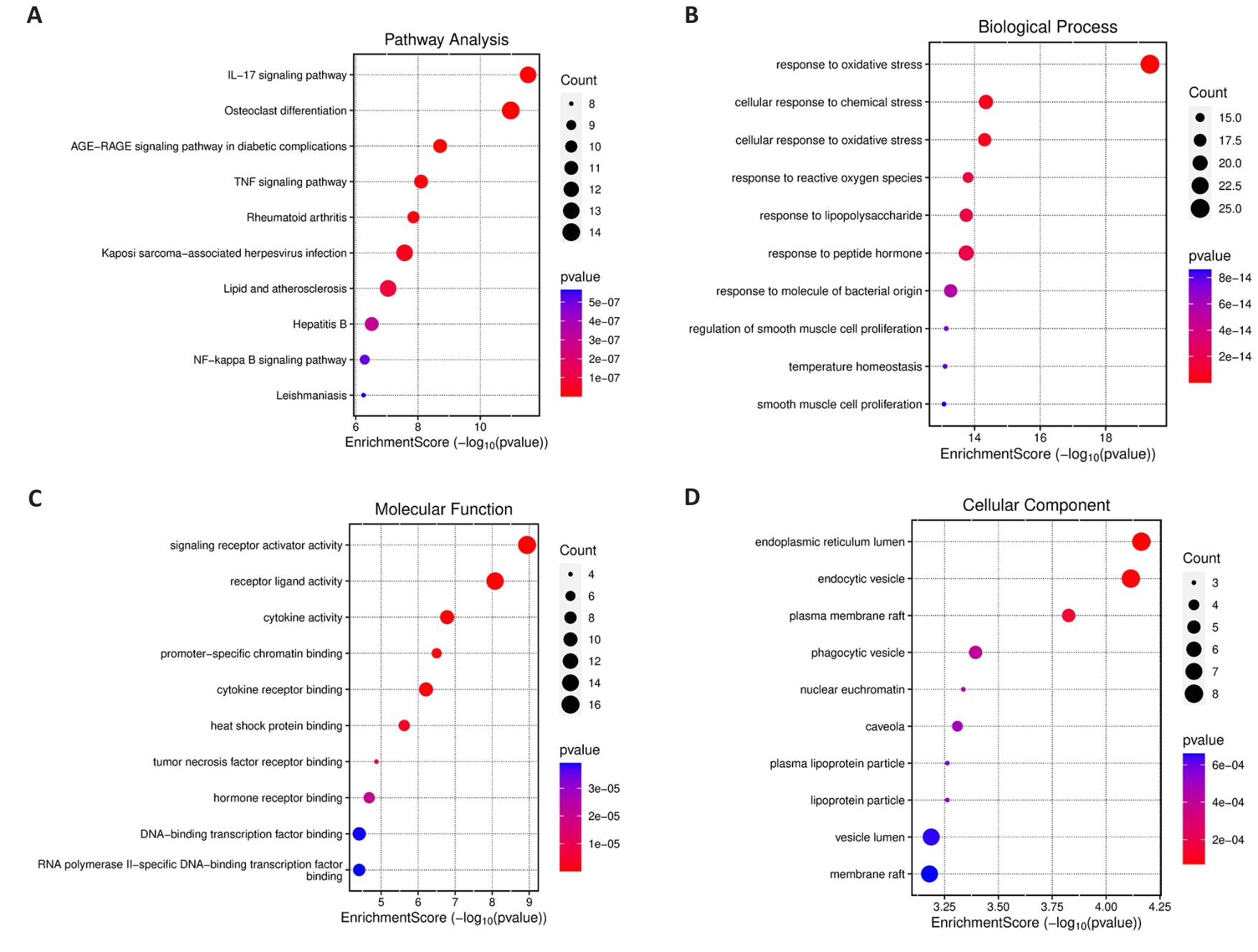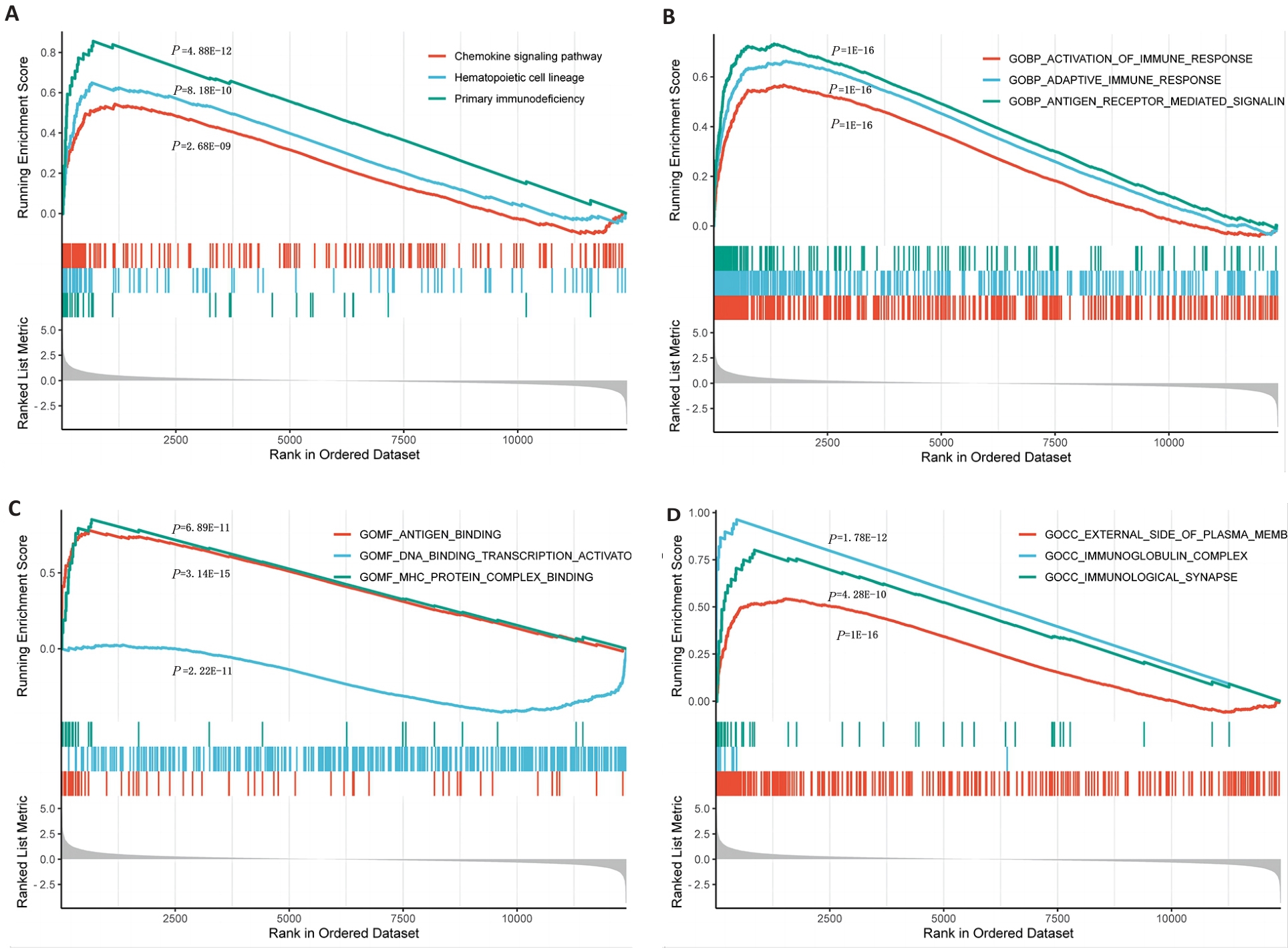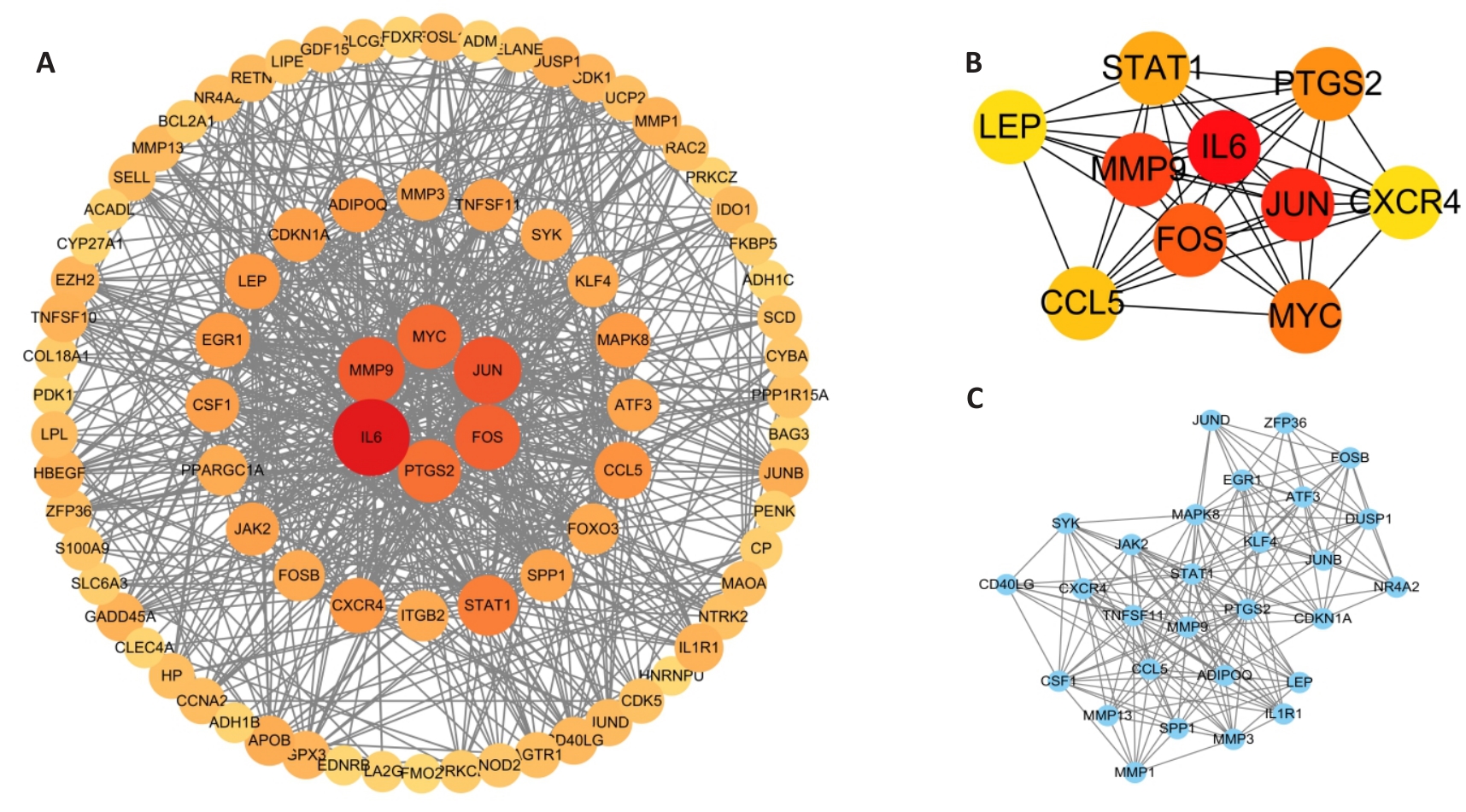南方医科大学学报 ›› 2025, Vol. 45 ›› Issue (4): 862-870.doi: 10.12122/j.issn.1673-4254.2025.04.22
收稿日期:2024-09-06
出版日期:2025-04-20
发布日期:2025-04-28
通讯作者:
孙培养
E-mail:gaodaren2024@163.com;1162749719@qq.com
作者简介:高 志,在读硕士研究生,E-mail: gaodaren2024@163.com
基金资助:
Zhi GAO1( ), Ao WU2, Zhongxiang HU3,4, Peiyang SUN5(
), Ao WU2, Zhongxiang HU3,4, Peiyang SUN5( )
)
Received:2024-09-06
Online:2025-04-20
Published:2025-04-28
Contact:
Peiyang SUN
E-mail:gaodaren2024@163.com;1162749719@qq.com
摘要:
目的 探索类风湿关节炎中氧化应激和免疫浸润的作用。 方法 从GEO数据库中获取类风湿关节炎数据集GSE55235(10例类风湿关节炎样本和10例健康对照样本)和GSE55457(13例类风湿关节炎样本和10例健康对照样本),将两个数据集作为实验数据集进行合并,使用R语言获取类风湿关节炎样本和正常关节样本的差异表达基因,并与氧化应激相关基因取交集得到差异表达氧化应激基因。对差异表达氧化应激基因进行KEGG和GO富集分析,利用GSEA方法评估与类风湿关节炎相关的通路和生物过程。使用STRING在线平台和Cytoscape软件构建蛋白质相互作用网络,使用Cytoscape软件中的Degree算法计算出前10名关键基因。从GEO数据库中获取到数据集GSE1919作为验证数据集,对计算出的前十名关键基因进行验证及ROC曲线分析,得到核心基因。利用CIBERSORT来评估免疫细胞的浸润情况,使用qRT-PCR验证得到的结果的准确性。 结果 得到了89个差异表达氧化应激基因;富集分析结果显示,差异表达氧化应激基因的主要聚焦点包括氧化应激、化学应激的反应、对活性氧的反应和脂多糖反应等生物学过程;得到了5个核心基因(STAT1、MMP9、MYC、CCL5、JUN),5个核心基因的ROC曲线下面积都大于0.7,其对类风湿关节炎的预测具有良好的敏感性和特异性;核心基因与免疫细胞密切相关,且大多与T细胞相关;qRT-PCR结果显示,5个核心基因在类风湿关节炎样本和正常关节样本中的表达存在显著差异(P<0.05)。 结论 类风湿关节炎中存在氧化应激与免疫反应过程,且免疫反应参与激活氧化应激,核心基因及可作为诊断类风湿关节炎的新型标志物。
高志, 吴傲, 胡仲翔, 孙培养. 类风湿性关节炎中氧化应激与免疫浸润的生物信息学分析[J]. 南方医科大学学报, 2025, 45(4): 862-870.
Zhi GAO, Ao WU, Zhongxiang HU, Peiyang SUN. Bioinformatics analysis of oxidative stress and immune infiltration in rheumatoid arthritis[J]. Journal of Southern Medical University, 2025, 45(4): 862-870.
| Gene | Upstream primer (5'→3') | Downstream primer (5'→3') |
|---|---|---|
| JUN | GCTGAGCCTACAGATGAACT | GGCAGGATACCCAAACAAAC |
| MYC | TACACTAACATCCCACGCTC | TATAAATCATCGCAGGCGGA |
| MMP9 | TTCCAGTACCGAGAGAAAGC | CACTGCAGGATGTCATAGGT |
| STAT1 | CTGTGAAGTTGAGAGATGTGA | CAGTAACGATGAGAGGACCC |
| CCL5 | GCCCTCGCTGTCATCCTCAT | AGCACTTGCCACTGGTGTAG |
表1 5名核心基因的引物序列
Tab.1 Primer sequences of the 5 core genes
| Gene | Upstream primer (5'→3') | Downstream primer (5'→3') |
|---|---|---|
| JUN | GCTGAGCCTACAGATGAACT | GGCAGGATACCCAAACAAAC |
| MYC | TACACTAACATCCCACGCTC | TATAAATCATCGCAGGCGGA |
| MMP9 | TTCCAGTACCGAGAGAAAGC | CACTGCAGGATGTCATAGGT |
| STAT1 | CTGTGAAGTTGAGAGATGTGA | CAGTAACGATGAGAGGACCC |
| CCL5 | GCCCTCGCTGTCATCCTCAT | AGCACTTGCCACTGGTGTAG |

图1 差异表达基因和差异表达氧化应激基因获取
Fig.1 Differentially expressed genes (DEGs) in rheumatoid arthritis (RA) and oxidative stress-associated genes. A: Volcano diagram of the DEGs in RA. B: Heat map of the DEGs (blue represents the control group, and red the disease group; on the scale bar, red represents up-regulation and green represents down-regulation. A darker color indicates a higher gene expression level). C: Wayne diagram of the DEGs and oxidative stress-related genes showing 89 intersected genes.

图2 DEOSGs的KEGG和GO富集分析
Fig.2 KEGG and GO enrichment analysis of DEOSGs. A: The top 10 KEGG pathway enrichment bubbles of DEOSGs. B-D: Bubble diagrams of GO enrichment results showing the top 10 biological processes, molecular functions, and cellular components.

图3 GSEA富集分析
Fig.3 GSEA enrichment analysis. A: Three KEGG pathways. B: Three GO biological processes. C: Three GO molecular functions. D: Three GO cell components.

图4 DEOSGs的蛋白互作网络
Fig.4 Protein interaction networks of DEOSGs. A: Protein interaction network of DEOSGs. B: The top 10 key genes obtained by the Degree algorithm. C: The module with the highest MCODE score.
| 1 | Cush JJ. Rheumatoid arthritis: early diagnosis and treatment[J]. Med Clin North Am, 2021, 105(2): 355-65. |
| 2 | Shimizu Y, Ntege EH, Azuma C, et al. Management of rheumatoid arthritis: possibilities and challenges of mesenchymal stromal/stem cell-based therapies[J]. Cells, 2023, 12(14): 1905. |
| 3 | Firestein GS, McInnes IB. Immunopathogenesis of rheumatoid arthritis[J]. Immunity, 2017, 46(2): 183-96. |
| 4 | 岳进茹, 张育敏, 刘静淑, 等. 独活寄生汤含药血清细胞外囊泡对类风湿关节炎滑膜成纤维细胞的影响[J/OL]. 中国组织工程研究, 2024: 1-9. (2024-06-27). . |
| 5 | Fois AG, Paliogiannis P, Sotgia S, et al. Evaluation of oxidative stress biomarkers in idiopathic pulmonary fibrosis and therapeutic applications: a systematic review[J]. Respir Res, 2018, 19(1): 51. |
| 6 | Meng F, Lu S, Li L, et al. Different gender of oxidative balance score on the risk of rheumatoid arthritis in the US population from NHANES[J]. Int J Rheum Dis, 2024, 27(7): e15237. |
| 7 | Kardeş S, Karagülle M, Durak İ, et al. Association of oxidative stress with clinical characteristics in patients with rheumatoid arthritis[J]. Eur J Clin Investigation, 2018, 48(1): e12858. |
| 8 | Vasanthi P, Nalini G, Rajasekhar G. Status of oxidative stress in rheumatoid arthritis[J]. Int J Rheum Dis, 2009, 12(1): 29-33. |
| 9 | Kan S, Duan M, Liu Y, et al. Role of mitochondria in physiology of chondrocytes and diseases of osteoarthritis and rheumatoid arthritis[J]. Cartilage, 2021, 13(): 1102S-21S. |
| 10 | 汪敏杰, 孙大卫, 杭明辉, 等. 针刺治疗膝骨关节炎的疗效及其机制的研究进展[J]. 世界中医药, 2024, 19(13): 2011-7. |
| 11 | 闵远骞, 李 姗, 刘湘花, 等. 活性氧/活性氮与NF-κB信号通路级联交互在肝纤维化中的作用[J]. 临床肝胆病杂志, 2023, 39(6): 1454-60. |
| 12 | Benchabane S, Sour S, Zidi S, et al. Exploring the relationship between oxidative stress status and inflammatory markers during primary Sjögren's syndrome: a new approach for patient monitoring[J]. Int J Immunopathol Pharmacol, 2024, 38: 3946320241263034. |
| 13 | Mateen S, Moin S, Khan AQ, et al. Increased reactive oxygen species formation and oxidative stress in rheumatoid arthritis[J]. PLoS One, 2016, 11(4): e0152925. |
| 14 | Zhang W, Wu H, Liao Y, Zhu C, Zou Z. Caspase family in autoimmune diseases. Autoimmun Rev. 2024 Dec 3;24(2):103714. |
| 15 | 吴 傲,于 鹏, 滕加文, 等.骨关节炎的氧化应激相关基因和免疫浸润分析[J].中国组织工程研究, 2025, 29(02): 302-311. |
| 16 | Liberzon A, Birger C, Thorvaldsdóttir H, et al. The Molecular Signatures Database (MSigDB) hallmark gene set collection[J]. Cell Syst, 2015, 1(6): 417-25. |
| 17 | Gu X, Lai D, Liu S, et al. Hub genes, diagnostic model, and predicted drugs related to iron metabolism in Alzheimer's disease[J]. Front Aging Neurosci, 2022, 14: 949083. |
| 18 | Deng CF, Zhang Q, He PH, et al. Targeted apoptosis of macrophages and osteoclasts in arthritic joints is effective against advanced inflammatory arthritis[J]. Nat Commun, 2021, 12: 2174. |
| 19 | Jang S, Kwon EJ, Lee JJ. Rheumatoid arthritis: pathogenic roles of diverse immune cells[J]. Int J Mol Sci, 2022, 23(2): 905. |
| 20 | 李朝霞, 高 鲁, 张晓峰, 等.铁死亡在类风湿性关节炎中的研究进展[J].中国骨质疏松杂志, 2024, 30(06): 889-94. |
| 21 | Hirvonen H, Kautiainen H, Moilanen E, et al. The effect of cryotherapy on total antioxidative capacity in patients with active seropositive rheumatoid arthritis[J]. Rheumatol Int, 2017, 37(9): 1481-7. |
| 22 | 赵 磊, 万 磊, 刘 健, 等. 新风胶囊通过调节Notch1通路、巨噬细胞极化改善类风湿关节炎大鼠关节炎症[J]. 中医学报, 2023, 38(1): 120-6. |
| 23 | Miossec P, Kolls JK. Targeting IL-17 and TH17 cells in chronic inflammation[J]. Nat Rev Drug Discov, 2012, 11: 763-76. |
| 24 | 杨娟娟, 李浩林, 杨天宁, 等. 祖师麻膏药对胶原诱导型关节炎小鼠炎症及骨破坏的抑制作用[J]. 中国临床药理学与治疗学, 2024, 29(9): 979-87. |
| 25 | Honorati MC, Neri S, Cattini L, et al. Interleukin-17, a regulator of angiogenic factor release by synovial fibroblasts[J]. Osteoarthr Cartil, 2006, 14(4): 345-52. |
| 26 | Xin R, Xu Y, Long D, et al. Mitochonic acid-5 inhibits reactive oxygen species production and improves human chondrocyte survival by upregulating SIRT3-mediated, parkin-dependent mitophagy[J]. Front Pharmacol, 2022, 13: 911716. |
| 27 | Chabaud M, Garnero P, Dayer JM, et al. Contribution of interleukin 17 to synovium matrix destruction in rheumatoid arthritis[J]. Cytokine, 2000, 12(7): 1092-9. |
| 28 | 刘 琴, 魏建波. ROC曲线评价MMP-2和MMP-9在类风湿关节炎诊断中的价值[J]. 中国卫生检验杂志, 2014, 24(4): 531-3. |
| 29 | Zou J, Li XL, Shi ZM, et al. Effects of C-myc gene silencing on interleukin-1β-induced rat chondrocyte cell proliferation, apoptosis and cytokine expression[J]. J Bone Miner Metab, 2018, 36(3): 286-96. |
| 30 | 胡 伟, 荣 超, 陈飞虎, 等. 基质金属蛋白酶在类风湿关节炎发病机制中的作用研究进展[J]. 安徽医学, 2011, 32(5): 671-3. |
| 31 | Van Raemdonck K, Umar S, Palasiewicz K, et al. Interleukin-34 reprograms glycolytic and osteoclastic rheumatoid arthritis macrophages via syndecan 1 and macrophage colony-stimulating factor receptor[J]. Arthritis Rheumatol, 2021, 73(11): 2003-14. |
| 32 | Wu A, Yang ZK, Kong P, et al. Exploring osteosarcoma based on the tumor microenvironment[J]. Front Immunol. 2024 11(15): 1423194. |
| 33 | Sakuraba K, Krishnamurthy A, Sun JT, et al. Autoantibodies targeting malondialdehyde-modifications in rheumatoid arthritis regulate osteoclasts via inducing glycolysis and lipid biosynthesis[J]. J Autoimmun, 2022, 133: 102903. |
| 34 | Yoshida S, Arakawa F, Higuchi F, et al. Gene expression analysis of rheumatoid arthritis synovial lining regions by cDNA microarray combined with laser microdissection: up-regulation of inflammation-associated STAT1 IRF1 CXCL9 CXCL10 and CCL5[J]. Scand J Rheumatol, 2012, 41(3): 170-9. |
| 35 | Lu H, Hou G, Zhang Y, et al. C-Jun transactivates Puma gene expression to promote osteoarthritis[J]. Mol Med Rep, 2014, 9(5): 1606-12. |
| 36 | Ye Z, Chen Y, Zhang R, et al. C-Jun N-terminal kinase-c-Jun pathway transactivates Bim to promote osteoarthritis[J]. Can J Physiol Pharmacol, 2014, 92(2): 132-9. |
| 37 | Bleck D, Loacker-Schöch K, Classen T, et al. Fibroblast-like synoviocytes preferentially induce terminal differentiation of IgD+ memory B cells instead of naïve B cells[J]. Immunology, 2024, 173(3): 520-35. |
| 38 | Floudas A, Neto N, Marzaioli V, et al. Pathogenic, glycolytic PD-1+ B cells accumulate in the hypoxic RA joint[J]. JCI Insight, 2020, 5(21): 139032. |
| 39 | Álvarez K, Palacio J, Agudelo NA, et al. B cell-targeted polylactic acid nanoparticles as platform for encapsulating jakinibs: potential therapeutic strategy for systemic lupus erythematosus[J]. Nanomedicine, 2023, 18(27): 2001-19. |
| 40 | Wu F, Gao J, Kang J, et al. B cells in rheumatoid arthritis: pathogenic mechanisms and treatment prospects[J]. Front Immunol, 2021, 12: 750753. |
| [1] | 陈鑫源, 吴成挺, 李瑞迪, 潘雪芹, 张耀丹, 陶俊宇, 林才志. 双术汤通过P53/SLC7A11/GPX4通路诱导胃癌细胞铁死亡[J]. 南方医科大学学报, 2025, 45(7): 1363-1371. |
| [2] | 李玮怡, 江露, 张宗星, 陈丹, 包卓玛, 黄丽, 袁林. 强骨康疏方通过抑制HIF-1α/BNIP3自噬信号通路减少类风湿性关节炎大鼠的破骨细胞分化[J]. 南方医科大学学报, 2025, 45(7): 1389-1396. |
| [3] | 王静娴, 任自敬, 周佩洋. S1PR5激动与过表达通过调控氧化应激增强脑微血管内皮细胞屏障功能抵抗氧糖剥夺/复氧复糖损伤[J]. 南方医科大学学报, 2025, 45(7): 1451-1459. |
| [4] | 庞金龙, 赵新丽, 张振, 王豪杰, 周星琦, 杨玉梅, 李姗姗, 常小强, 李锋, 李娴. 皮肤黑色素瘤中MMRN2高表达促进肿瘤细胞的侵袭和迁移并与不良预后相关[J]. 南方医科大学学报, 2025, 45(7): 1479-1489. |
| [5] | 王康, 李海宾, 余靖, 孟源, 张虹丽. ELFN1高表达是结肠癌的预后生物标志物并促进结肠癌细胞的增殖转移[J]. 南方医科大学学报, 2025, 45(7): 1543-1553. |
| [6] | 郭晓娟, 杜瑞娟, 陈丽平, 郭克磊, 周彪, 卞华, 韩立. WW结构域E3泛素连接酶1调控卵巢癌肿瘤微环境中的免疫浸润[J]. 南方医科大学学报, 2025, 45(5): 1063-1073. |
| [7] | 张安邦, 孙秀颀, 庞博, 吴远华, 时靖宇, 张宁, 叶涛. 电针预处理通过调节肠道-大脑轴及Nrf2/HO-1信号通路抑制铁死亡减轻大鼠脑缺血再灌注损伤[J]. 南方医科大学学报, 2025, 45(5): 911-920. |
| [8] | 黄鹏伟, 陈洁, 邹金虎, 高雪锋, 曹虹. 槲皮素促进应激颗粒G3BP1解聚改善HIV-1 gp120诱导的星形胶质细胞神经毒性[J]. 南方医科大学学报, 2025, 45(2): 304-312. |
| [9] | 曹周芳, 汪元, 王梦娜, 孙玥, 刘菲菲. LINC00837/miR-671-5p/SERPINE2功能轴促进类风湿关节炎成纤维细胞样滑膜细胞的恶性病理学过程[J]. 南方医科大学学报, 2025, 45(2): 371-378. |
| [10] | 许怀文, 翁丽, 薛鸿. CXCL12可作为2型糖尿病合并慢性阻塞性肺疾病的潜在治疗靶点[J]. 南方医科大学学报, 2025, 45(1): 100-109. |
| [11] | 王耀彬, 陈柳燕, 罗伊凌, 申继清, 周素芳. NUF2对泛癌的预后和免疫治疗效果的预测价值[J]. 南方医科大学学报, 2025, 45(1): 137-149. |
| [12] | 展俊平, 黄硕, 孟庆良, 范围, 谷慧敏, 崔家康, 王慧莲. 缺氧微环境下补阳还五汤通过抑制BNIP3-PI3K/Akt通路抑制类风湿关节炎滑膜成纤维细胞的线粒体自噬[J]. 南方医科大学学报, 2025, 45(1): 35-42. |
| [13] | 叶梦楠, 武鸿美, 梅琰, 张庆玲. CREM在胃癌中高表达并与患者的不良预后相关[J]. 南方医科大学学报, 2024, 44(9): 1776-1782. |
| [14] | 杨锐, 舒翊秦, 文晖杰, 蔡熹, 王震, 张棽, 向阳, 吴昊. 枫杨总黄酮通过抑制中性粒细胞胞外陷阱网的释放减轻大鼠类风湿关节炎[J]. 南方医科大学学报, 2024, 44(9): 1645-1652. |
| [15] | 纪凯, 于冠宇, 周乐其, 张天帅, 凌潜龙, 满文江, 朱冰, 张卫. HNRNPA1基因在结直肠癌组织中高表达及其潜在的诊断和治疗价值[J]. 南方医科大学学报, 2024, 44(9): 1685-1695. |
| 阅读次数 | ||||||
|
全文 |
|
|||||
|
摘要 |
|
|||||